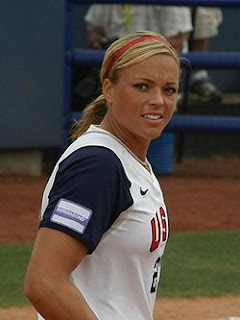
PLANT CITY, Fla. — The 2011 USA Softball Women’s National Team made their first appearance Saturday in Plant City, Fla., in two controlled exhibition games against the 2010-11 USA Softball Junior Women’s National at Plant City Stadium. With both teams playing their compatriots for experience before heading into international play, the Women’s National Team defeated the Junior Women’s National Team 13-1 in Game 1 and 12-0 in Game 2.
For 11 members of the Women’s National Team, including NCAA Women’s College World Series (WCWS) co-Most Outstanding Player Michelle Moultrie, the Plant City exhibitions marked their first time in a USA uniform. Other newcomers to the program are Whitney Canion, Lauren Gibson, Kelly Grieve, Taylor Hoagland, Stacey May-Johnson, Christi Orgeron, Keilani Ricketts, Brittany Schutte, Rhea Taylor and Chelsea Thomas.
“We are really a young team as we have had only one practice heading into tonight. I was pretty excited for our athleticism, that we had eight different people hit home runs and for the pitch counts of our pitchers,” said National Team Head Coach Ken Eriksen (Tampa, Fla.). We have some basic base running and defensive play we need to go over but as far as an assessment of the first game, I would give it a B. We have a long road to be really, really good but I am excited. These are some good ball players, 1-18, so it’s nice to see them start to come together as a unit. It just takes time to really start to gel and through our exhibitions and training, we will be able to do that before International play.”
Kaitlin Cochran, Ashley Holcombe and Jenae Leles were all members of the 2009 Women’s National Team while Cochran and Holcombe were also on the squad that won the 2010 International Softball Federation (ISF) Women’s World Championship. Valerie Arioto, Molly Johnson, Megan Langenfeld and Jordan Taylor have international experience as pick up players for previous tournaments in Canada, Japan, and Venezuela. Arioto, Johnson, Langenfeld, Leles and Taylor also played on the USA Softball Women’s Futures National Team at the 2010 World Cup of Softball in Oklahoma City.
The Women’s National Team had no offensive shortage, taking advantage of a Junior Women’s National Team that tinkered with defensive lineups throughout the night. The juniors used all but two members of its pitching staff in Game 1, saving incoming Florida pitcher Lauren Haeger and Dallas Escobedo, the co-Most Outstanding Player of the WCWS, for Game 2. Haeger struck out a team high three batters while Ally Carda, Escobedo and Nyree White each had a pair of strikeouts.
“For me as a pitcher, it was all about learning how to hit your spots better and working more off the plate than I am used to. Hitting wise, it was a great learning experience facing some great pitchers at top level,” said Carda of her experience facing the National Team. “For us as a team to put the ball into play against these great pitchers was amazing. For me I would like to get ahead in the count as that was my struggle tonight. As a team, we have great chemistry. We just need to work on putting all our base hits together because we are spreading them throughout the game now.”
Cochran, Gibson and Holcombe all had home runs for the National Team in Game 1 while Arioto, Hoagland, Leles, Orgeron and Schutte had homers in Game 2. The National team hit 10 hits in the first game. In Game 2, they had a combined 12 hits.
For the juniors, Carda, Destinee Martinez and Hallie Wilson had a hit in Game 1 with Carda scoring Martinez on a sacrifice fly in the top of the sixth. They improved to five hits in Game 2. Carda, Lauren Chamberlain and Cheyenne Cordes each had one while Chelsea Goodacre contributed a pair. The team had 11 runners left on base throughout the doubleheader.
“We learned that you can’t throw a fatty down the middle. These girls are no joke. They have power. We need to execute the little things. Individually I need to learn how to hit the ball,” said Cordes. “As a team we have the chemistry we just need to pull it together.”
The Junior Women’s National Team athletes have not competed as a unit since the III Pan American Championship (18-Under) last August in Bogota, Colombia, where they went 9-0 for the Gold Medal. With the Colombian event serving as a qualifier for the ISF IX Junior Women’s World Championship in December, their focus is on preparing for the competition in Cape Town, South Africa.
The Women’s National Team and the Junior Women’s National Team will hold exhibition doubleheaders in Salem, Va., on June 29, and Bowie, Md., on July 1 before heading separate ways. The Women’s National Team will continue on to the Canadian Open FastPitch International Championship, July 9-17, in Surrey, B.C., and then the World Cup of Softball VI, July 21-25, in Oklahoma City. Ticket information for upcoming appearances is available at USASoftball.com.
The USA Softball Women’s National Team will seek the program’s ninth Pan American Games title, Oct. 17-23, in Guadalajara, Mexico for the final competition of 2011. Two months later, the juniors head to South Africa to close out the year for USA Softball.


